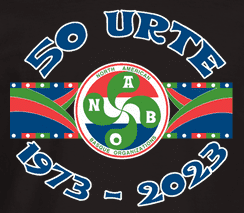Back in May, at the Los Banos Picnic, N.A.B.O. held its annual convention. This one was particularly special, as it marked 50 years since the founding of the federation of Basque clubs and entities. During the last 50 years, N.A.B.O. has helped bring the Basque community of the United States and beyond together by hosting a myriad of events and providing resources to help individual clubs. Zorionak N.A.B.O.!

- The North American Basque Organizations, or N.A.B.O., was formed in 1973 with the goal of bringing together the various and disparate Basque clubs and groups around the United States. That year, a group of like-minded Basques met in Elko, Nevada to discuss the formation of an umbrella organization. The first Basque festival open to the public in the western United States had only been held a handful of years before, in 1959 in Sparks, Nevada, but that event catalyzed similar festivals in other towns, creating both a community of Basque-Americans but also a need for some coordination between the clubs.
- One spark for the formation of N.A.B.O. came from FEVA, the Federación de Entidades Vasco Argentinas. FEVA is an umbrella organization for the Basque entities in Argentina. In 1971, Jon Bilbao and William Douglass, of the Basque Studies Program at the University of Nevada, Reno, travelled to Argentina to learn about the Basques there, and discovered FEVA. Bilbao returned to Reno convinced that a similar organization needed to be created in the United States. After some cajoling, he convinced the reticent Douglass that it was indeed a good idea. Along with Janet Inda, they reached out to the Basques of Boise and San Francisco to discuss the idea.
- However, stories differ, and the Boise Basques provide a different origin story. They had received a grant from the National Endowment for the Humanities and used some of that funding to create the Idaho Basque Studies Center (IBSC) which, in 1972, reached out to other Basque clubs in the United States with the goal of creating a federation of Basque clubs. This outreach was led by Al Erquiaga and Miren Rementeria, both of the IBSC. Rementeria and Erquiaga were the leads of that initial meeting in Elko in 1973.
- In their second meeting, in June 1973, the representatives of various Basque clubs adopted the name North American Basque Organizations, replacing the previously used Western States Basque Federation, in recognition that there were Basque clubs in other parts of the United States. Only two months later, N.A.B.O. held its first convention in Reno where Erquiaga was elected the first president of N.A.B.O.
- The primary objective of N.A.B.O. is “the perpetuation of ‘Basqueness‘ (Basque culture & identity).” This includes cultivating relations between the member entities, recognizing outstanding contributions by Basques or to the Basque culture, and educate both the members and the general public about the Basques.
- Three of the biggest efforts N.A.B.O. undertakes to achieve these objectives are their annual music camp (now called Udaleku), mus tournament, and pelota tournament. The first of each of these was in 1977, 1977, and 1976, respectively. They also provide educational materials to clubs, including resources to teach Euskara.
- Today N.A.B.O. boasts members from twelve different states, the District of Columbia, and Canada. There is technically even a club from France, as Saint Pierre and Miquelon, though a group of islands off of Newfoundland, is strictly French territory.
Primary source: The North American Basque Organizations (NABO), Incorporated. 1973-2007, Argitxu Camus Etchecopar.


It is fun to meet with like minded people. That said, and it is just my opinion, this idea of Basqueness is an obsession with some Basque –obsession is not healthy and it could be damaging.
Yes, the flag of St. Pierre and Miquelon contains the Ikurina–the flag designed by Sabino Arana. The red for Basque blood, the green cross of St. Andrew, the color of the oak of Biscaye represents the law above the people and the white is the law of Christ that reigns over the people and the law. Wow! we all have to meet our maker someday. The good and the bad, every thing is tabulated.
It may have been some ignorant politician who put Arana’s flag and ultimately ETA’s flag —ETA responsible for the death of so many innocent people. Regardless how one slices it, 4 Basque provinces fly the Spanish flag and the other 3, fly the French flag. And Idaho is still a state in the United States of America. Not the eighth province of the Basque Region.
Navarre is a foral community and refuses to be attached to Euskadi.
Happy fourth of July! Dance, eat and drink ( in moderation) and have fun.
Monique